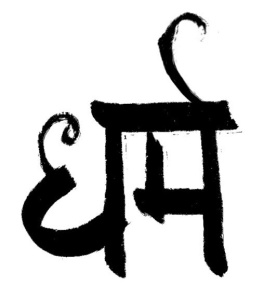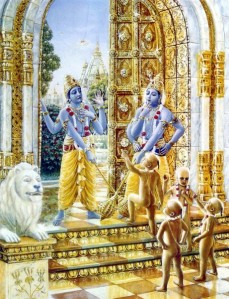
The one word that will be used again and again in Mahabharat is Dharma, yet this is one of those words that defy an accurate description. But since atleast a rudimentary understanding of the word is important to understand Mahabharat, I will try to make an effort towards explaining it nonetheless.
When I was watching the Mahabharat on Youtube, I literally cringed every time they translated Dharma as ‘Religion’. This was quite shocking as the Hindi dialogues were quite beautiful and this kind of literary lapse was really not expected from the production house that had done an exemplary job of writing the original dialogues.
Peter Brooks was a far wiser man in this regard I guess, as rather than looking for any one word that could be used in place of Dharma, he used the word as is and left it to the viewers to do their own research about what Dharma means. Quite a bold move, given that the entire point of Mahabharat is the quest to understand Dharma.
For those not familiar with Dharma, they can substitute it with Righteousness when watching the series. However Dharma has a far deeper meaning than that and of all the things it can mean, ‘religion’ is the very last on the list and a fairly new meaning of the word.
Dharma is quite a mixture of many ideas; Righteousness, duty, that which upholds the universe, the reason for being are the more important ones. In the last 80 odd years it has also come to be used to mean Religion however there is no word in Hindi, Sanskrit or any other Indian languages that has the same meaning as Religion has for western religions.
Dharma in Hindu context means the sacred and righteous duty of every one that helps in maintaining order in the Universe. It is therefore the raison d’être of everything that exists and contributes to the world. By this definition even a tree can have a Dharma while it obviously can’t have a Religion. Its Dharma would be to provide fruit and shade to others. It may not pursue it actively but that’s the reason why the tree exists.
Sometimes Dharma was a set of duties that we are either born into or acquire as we find our place in the world. Kshatriya Dharma or the Dharma of a warrior would be to protect his country and the society he is responsible for.
While everyone who exists must have a Dharma, Dharma itself is not contained within individuals only. It also means natural justice or the Eternal Law That Uphold The Universe or Sanatan Dharma. Which is why the word Hindu is not found in any sacred Hindu text but Sanatan Dharma does. Sanatan means eternal. So this means that when one says that ‘the Dharma of a warrior is to uphold Dharma’ it would mean that ‘the sacred duty of a warrior is to ensure that the sense of justice is protected.’
One’s Dharma in ancient Indian society depended on several things like what family one is born into, one’s stage in life, their chosen profession etc. This clear demarcation of duties meant that people knew exactly what the society expected of them. This helped in the smooth functioning of society and that’s how Dharma ‘upheld the universe’, “Prithvim Dharman Dhritam” (Dharma upholds the World – Atharva Veda).
It is difficult to provide a single concise definition for “Dharma”.
A common manner of describing Hinduism among its adherents is as a way of life, as “Dharma.” It defies dogma and thus seeks to instead align the human body, mind, and soul in harmony with nature.
Our very limitation is guided under a universal understanding, that of Dharma. The Atharva Veda, the last of the four books of the Vedas, utilizes symbolism to describe dharma’s role. That we are bound by the laws of time, space and causation is only a finite reality, a limitation imposed by the self-projection of the infinite Brahman as the cosmos. Dharma is the foundation of this causal existence, the one step below the infinite. Indeed, dharma is the projection of divine order from Brahman, and as such Dharma is what upholds the Universe and its axis or fulcrum.
The Upanishads saw dharma as the universal principle of law, order, harmony, all in all truth, that sprang first from Brahman. It acts as the regulatory moral principle of the universe. It is sat, truth, a major tenet of Hinduism. This hearkens back to the conception of the Rig Veda that “Ekam Sat,” (Truth Is One), of the idea that Brahman is “Sacchidananda” (Truth-Consciousness-Bliss). Dharma has imbibed the highest principles of Truth, and as such is the central guiding principle in the Hindu conception of existence. Dharma is not just law, or harmony, it is pure Reality.
Dharma is still more complicated but I think this should help most people to understand the basic premise of what all is covered under Dharma.









